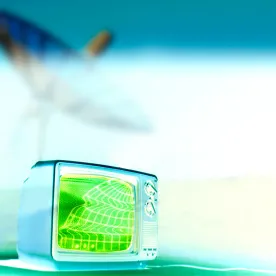The Supreme Court of the United States announced an important copyright decision Wednesday in American Broadcasting Cos. v. Aereo, Inc. (573 U.S. ____ (2014)). The 6-3 decision by Justice Breyer reversing the United States Court of Appeals for the Second Circuit appears, on its face, to grant significant protection to traditional media business models, but leaves emerging technologies capable of providing broadcast content over the internet without clear guidelines as to what might constitute a copyright violation. Although the Court was careful to limit its holdings to the facts of this case, companies – not just emerging technology companies – should take note that it just got harder to design around U.S. copyright laws. For Aereo, however, the decision clearly shuts down the company absent entry into licensing agreements for content.
Aereo operates a television streaming service that transmits to subscribers almost real-time television programs over the Internet via a network of thousands of small antennas and other equipment centrally housed. Each antenna is dedicated to a particular subscriber, which is manipulated by Aereo's systems to deliver a requested television channel to a subscriber's dedicated folder. A copy of the requested television show is then streamed to the subscriber's screen after several seconds of the show have been saved. The subscriber is then able to view a requested television show with a few second delay after the on-air broadcast.
The American Broadcasting Companies and other broadcasters, marketers, producers and distributors of television programing (collectively, "Petitioners") sued Aereo for copyright infringement. Specifically, the Petitioners alleged that Aereo violated 17 U.S.C. § 106(4) of the Copyright Act of 1976, which provides copyright owners the exclusive right to "perform the copyright work publicly."
The Supreme Court decision focused on two key points.1 First, the Court acknowledged that amendments to the Copyright Act rejected prior Supreme Court decisions concerning the meaning of "perform." The Court recognized that the amendments "erased the Court's line between broadcaster and viewer" with respect to performing a work and increased the concept of performance to encompass any audiovisual work that "shows its images in any sequence or "make[s] sounds accompanying it audible." In addition, Congress also added the so-called Transmit Clause, which provided that an entity "performs" whenever it "transmit[s] . . . a performance . . . to the public."
Second, the Court analogized Aereo's method of transmitting programming to community antenna television (CATV) providers, the "precursors of modern cable systems." According to the Supreme Court, "Aereo sells a service that allows subscribers to watch television programs, many of which are copyrighted, almost as they are being broadcast." The Court continued, "[b]y means of its technology (antennas, transcoders, and servers), Aereo's system 'receive[s] programs that have been released to the public and carr[ies] them by private channels to additional viewers.'"
The dissent raised what it viewed as a critical distinction between Aereo's service and traditional CATV operators: the latter transmits constantly while the former permits the viewer to select the copyrighted content that gets "performed." Accordingly, the dissent argued that the viewer, and not Aereo, is the party "transmitting" the performance. The dissent drew an analogy of its own to an equally outdated technology – "a copy shop that provides its patrons with a library card."
The majority dismissed this argument as making "too much out of too little," stating the "sole technological difference between Aereo and traditional cable companies does not make a critical difference." Yet, crucially, the Supreme Court suggested in no uncertain terms that in "other cases involving different kinds of service or technology providers, a user's involvement in the operation of the provider's equipment and selection of the content transmitted may well bear on whether" a copyright violation is occurring. The Court also devoted an entire section of its decision to describing the "limited nature" of its holding to address concerns that an adverse decision would "discourage the emergence or use of different kinds of technologies." Indeed, the Court expressly stated that "[q]uestions involving cloud computing, [remote storage] DVRs, and other novel issues not before the Court . . . [and] should await a case in which they are squarely presented." The Court concluded by all but inviting parties to lobby Congress to change the Copyright Act to clarify the scope of such technologies.
The opinion can be found on the Supreme Court's website.
1 The decision also concerned whether Aereo performs works "publicly." After a detailed statutory interpretation analysis, the Court concluded that, while the Copyright Act does not define "the public," the fact that Aereo "communicates the same contemporaneously perceptible images and sounds to a large number of people who are unrelated and unknown to each other" is sufficient to perform publicly.




 />i
/>i
